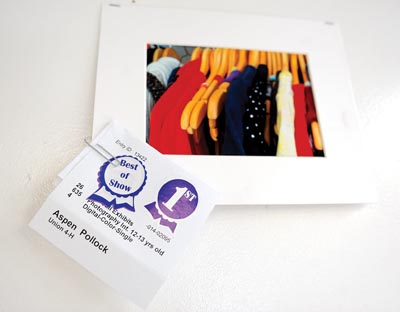
In many ways, Aspen Pollock is a typical 13-year-old. She enjoys
fashion and shopping and being social, said her mother, Razya
Pollock. She loves music and dancing. She is spontaneous.
In many ways, Aspen Pollock is a typical 13-year-old. She enjoys fashion and shopping and being social, said her mother, Razya Pollock. She loves music and dancing. She is spontaneous.
Aspen, whose family has lived in San Benito County for eight years, is partially blind and has a genetic disorder that limits her motor movements. It is called infantile refsum disease, and there is no cure. In most cases, the children do not survive.
Fortunately for Aspen, her case is considered “very mild,” her mother said, but she does face challenges with neurological, visual, speech and hearing impairment, among other issues.
Despite difficulty at times finding ways to freely express herself like other girls her age, Aspen has happened on an artform – in photography – that lets other people see how she views the world. This past weekend at the San Benito County Fair, she entered a photo in the 4-H contest for 12- and 13-year-olds and won first place, along with Best in Show, for her picture titled “I am blind but I can see.”
As decided before the contest, Aspen is donating the proceeds – $50 for the purchase of the photo and another $2 for winning first place – to The Global Foundation for Peroxisomal Disorders that conducts research for her disease and others like it.
The winning picture is a close-up view of her closet and a blend of varying, colorful clothes on hangers. It is fitting for Aspen, her mother noted, “what a 13-year-old is interested in.” And as usual, Aspen was drawn naturally to bright colors, an apparent result of her limited sight.
“I thought it’s something she can share with people, a form of expression, creative expression,” her mother said. “She doesn’t really get to express herself in many ways. It also helps her show people what she is thinking.”
Aspen’s curiosity in photography was spurred about two years ago when she had been playing with her father’s iPhone. She immediately was drawn to the photo application on the phone.
That led to the fair contest because Aspen takes part in Union 4-H. Her mother and the organization’s leaders had been trying to find ways for her to participate more, so photography fit well.
“Of all the things, photography is something she really knows how to do,” her mother said.
For the contest, Razya Pollock gave her daughter the assignment of walking around their Ridgemark house and taking pictures. The one of the closet was a common reflection of Aspen’s perspective, her mother said, as the teenage girl often finds contrasting colors in her photos, along with shadows.
“She’s very much drawn to things that are full of color or life,” Razya Pollock said.
It seems appropriate for the teenager’s outgoing personality. Just two weeks ago, she took part in a San Francisco 49ers program where she got to go on the field and cheer with the team’s cheerleaders during the game against the Dallas Cowboys. She finds other ways to get involved with 4-H, too, and she recently went along on a trip to the historical park.
While she has been embraced in 4-H, the same goes for students and staff at Southside School. Aspen’s mother has seen so many benefits from the iPhone, she hopes other new technologies can be incorporated into her education there. A tablet would help a lot, she said, with Aspen having trouble using a keypad and mouse.
Southside Principal Eric Johnson mentioned that a countywide special education organization has ordered some iPads. He said Aspen has a touch-screen computer to use in the classroom there and also is scheduled to get one of those new iPads.
Johnson said Aspen has a variety of jobs she does at school, mostly the life-skills variety.
“She really tries,” Johnson said. “It’s wonderful to see how the kids kind of rally to her.”
Her mother hopes that Aspen’s story shows that every child has talent.
“I want parents, families, no matter what kid you have, don’t give up on your child,” she said.
INFO ON THE WEB
The Global Foundation for Peroxisomal Disorders: http://www.thegfpd.org
What is Infantile Refsum disease?
Infantile Refsum disease (IRD) is a medical condition within the Zellweger spectrum of perixisome biogenesis disorders (PBDs), inherited genetic disorders that damage the white matter of the brain and affect motor movements. Symptoms of IRD begin in infancy with a visual impairment that often leads to blindness, and hearing problems that usually progress to deafness by early childhood. Other symptoms may include rapid, jerky eye movements (nystagmus); floppy muscle tone (hypotonia) and lack of muscle coordination (ataxia); mental and growth disabilities; abnormal facial features; enlarged liver; and white matter abnormalities of brain myelin.
Source: National Institute of Neurological Disorders and Stroke









